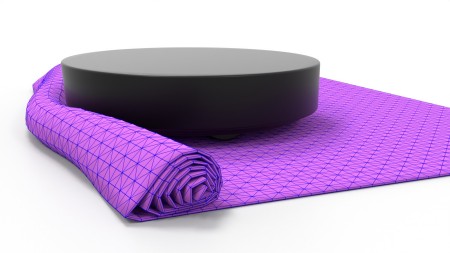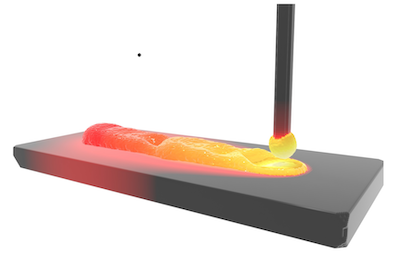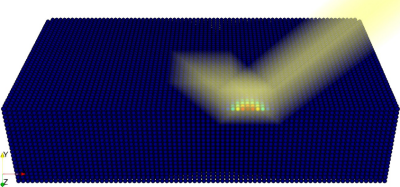Publications
STARK: A Unified Framework for Strongly Coupled Simulation of Rigid and Deformable Bodies with Frictional Contact

The use of simulation in robotics is increasingly widespread for the purpose of testing, synthetic data generation and skill learning. A relevant aspect of simulation for a variety of robot applications is physics-based simulation of robot-object interactions. This involves the challenge of accurately modeling and implementing different mechanical systems such as rigid and deformable bodies as well as their interactions via constraints, contact or friction. Most state-of-the-art physics engines commonly used in robotics either cannot couple deformable and rigid bodies in the same framework, lack important systems such as cloth or shells, have stability issues in complex friction-dominated setups or cannot robustly prevent penetrations. In this paper, we propose a framework for strongly coupled simulation of rigid and deformable bodies with focus on usability, stability, robustness and easy access to state-of-the-art deformation and frictional contact models. Our system uses the Finite Element Method (FEM) to model deformable solids, the Incremental Potential Contact (IPC) approach for frictional contact and a robust second order optimizer to ensure stable and penetration-free solutions to tight tolerances. It is a general purpose framework, not tied to a particular use case such as grasping or learning, it is written in C++ and comes with a Python interface. We demonstrate our system’s ability to reproduce complex real-world experiments where a mobile vacuum robot interacts with a towel on different floor types and towel geometries. Our system is able to reproduce 100% of the qualitative outcomes observed in the laboratory environment. The simulation pipeline, named Stark (the German word for strong, as in strong coupling) is made open-source.
» Show BibTeX
@INPROCEEDINGS{FLL+24,
author={Fernández-Fernández, José Antonio and Lange, Ralph and Laible, Stefan and Arras, Kai O. and Bender, Jan},
booktitle={2024 IEEE International Conference on Robotics and Automation (ICRA)},
title={STARK: A Unified Framework for Strongly Coupled Simulation of Rigid and Deformable Bodies with Frictional Contact},
year={2024}
}
Simulation of wire metal transfer in the cold metal transfer (CMT) variant of gas metal arc welding using the smoothed particle hydrodynamics (SPH) approach

Cold metal transfer (CMT) is a variant of gas metal arc welding (GMAW) in which the molten metal of the wire is transferred to the weld pool mainly in the short-circuit phase. A special feature here is that the wire is retracted during this strongly controlled welding process. This allows precise and spatter-free formation of the weld seams with lower energy input. To simulate this process, a model based on the particle-based smoothed particle hydrodynamics (SPH) method is developed. This method provides a native solution for the mass and heat transfer. A simplified surrogate model was implemented as an arc heat source for welding simulation. This welding simulation model based on smoothed particle hydrodynamics method was augmented with surface effects, the Joule heating of the wire, and the effect of the electromagnetic forces. The model of metal transfer in the cold metal transfer process shows good qualitative agreement with real experiments.
@article{MWW+24,
author = {Mokrov, O. and Warkentin, S. and Westhofen, L. and Jeske, S. and Bender, J. and Sharma, R. and Reisgen, U.},
title = {Simulation of wire metal transfer in the cold metal transfer (CMT) variant of gas metal arc welding using the smoothed particle hydrodynamics (SPH) approach},
journal = {Materialwissenschaft und Werkstofftechnik},
volume = {55},
number = {1},
pages = {62-71},
keywords = {cold metal transfer (CMT), free surface deformation, gas metal arc welding (GMAW), simulation, smoothed particle hydrodynamics (SPH), geglätteter Partikel-basierter hydrodynamischer Ansatz (SPH), Kaltmetalltransfer (CMT), Metallschutzgasschweißens, Oberflächenverformung, Simulation},
doi = {https://doi.org/10.1002/mawe.202300166},
year = {2024}
}
Ray tracing method with implicit surface detection for smoothed particle hydrodynamics-based laser beam welding simulations

An important prerequisite for process simulations of laser beam welding is the accurate depiction of the surface energy distribution. This requires capturing the optical effects of the laser beam occurring at the free surface. In this work, a novel optics ray tracing scheme is proposed which can handle the reflection and absorption dynamics associated with laser beam welding. Showcasing the applicability of the approach, it is coupled with a novel surface detection algorithm based on smoothed particle hydrodynamics (SPH), which offers significant performance benefits over reconstruction-based methods. The results are compared to state-of-the-art experimental results in laser beam welding, for which an excellent correspondence in the case of the energy distributions inside capillaries is shown.
@article{WKB+24,
author = {Westhofen, L. and Kruska, J. and Bender, J. and Warkentin, S. and Mokrov, O. and Sharma, R. and Reisgen, U.},
title = {Ray tracing method with implicit surface detection for smoothed particle hydrodynamics-based laser beam welding simulations},
journal = {Materialwissenschaft und Werkstofftechnik},
volume = {55},
number = {1},
pages = {40-52},
keywords = {heat transfer, hydrodynamics, laser beam welding, ray optics, ray tracing, smoothed particle, geglättete Partikel, hydrodynamische, Laserstrahlschweißen, Strahloptik, Strahlverfolgung, Wärmetransfer},
doi = {https://doi.org/10.1002/mawe.202300161},
year = {2024}
}
Previous Year (2023)

